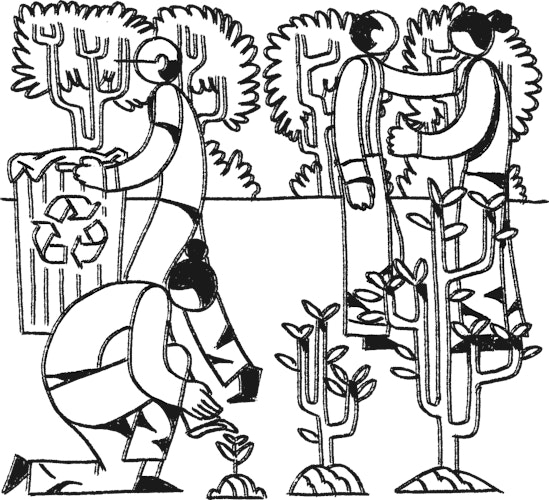The Many Faces of Madness
Directed by
“Madness is that which can be recognized as such – for example, a truck dumping chemical residues into the first available canal at night, or pumping them directly underground”. Or even greater madness – there are multitudes of individuals and institutions aware of this ecological disaster, yet it is not stopped.
“We have the information, but it provides us with no solutions; we see the effects, but we do not modify the causes. Are notions like the market and profit really so much more important than the fact that day after day life is being sacrificed?”
The forests are disappearing, fish populations are shrinking, average temperatures rise as the glaciers melt, and many animal and plant species are becoming extinct. “We are a nation waging war on our own air, earth and water. We believe we are masters of nature, forgetting we are actually a part of nature…”
Is it too late to save the planet through a wiser use of resources?
In-depth analysis
About the Movie The Many Faces of Madness
«“Global Vision – Notes on India” opens this year, for the first time, yet another window on a disappearing world. It is impossible in just a few documentary titles and limited programming time to give a truly exhaustive account of the environmental ruin that has followed the relentless drive towards modernisation and growth in a part of the world afflicted by the most desperate and apparently incurable under-development. We hope our viewers will welcome these titles with the same spirit of investigation and passion for the truth (the “relationship between power and powerlessness and the endless, circular conflict they’re engaged in” described so eloquently by writer Arundhati Roy) which inspired these films and informed their making. A gigantic commitment of time, effort and personal expense, driven by the need to testify, to record, to let people know and see the predicaments, the misdeeds, the immense human loss and suffering that the “global village”, for all its ubiquitous communication, cannot remotely begin to transmit.
The mad rush towards modernisation, the thoughtless exploitation of resources, rampant corruption, utter lack of planning: the “world's biggest democracy” is also and above all one of the youngest, risen from a history of thousands of years of devastating invasions and two centuries of British colonial rule.
The dreadful precedents of oppression and misgovernment – at the expense of India's masses, who today, as in the past, fall into the category of the “powerless” (the tribal populations, the Dalits, the faceless slaves of that democratically elected apartheid system which is the reality of Indian politics) – prove easier to imitate than exorcise.
Still today, in the remotest areas of India, resistance to power persists virtually unchanged. In some of the more isolated parts the older generation hasn't even noticed that in the meantime, there has been a declaration of Independence, that at some point the British left. This is the tale told by Amar Kanwar, in his sombre and magnificent Freedom, which escorts us to a tribal area of Orissa, where the struggle against mining has for over 60 years been so determined and cohesive that it has actually managed to score a few victories, Balco is one such case: 40 kilometres from Kashipur the company has been forced to close the pits and restore the land – fragrant with the perfume of medicinal plants and dotted with temples – to the Gods and Nature.
In other cases, where victory was less complete, the struggle has at least prevented the indigenous population being forced off their land. and averted the worst outcome of all, the deprivation of people's fundamental (at least in this part of the world) right to their roots.
“Freedom: it keeps happening, every time someone dies for the freedom of those left behind…”. comments the voice-over by Amar Kanwar. The struggle is truly endless in the images and stories we are given of this India: the struggle for survival, for the most basic human rights, for the sacred aspiration not to change, to live life according to age-old rhythms, honouring the same stories and forests, the same sunsets one's ancestors honoured. A slap in the face of the prevailing logic of progress, and a chance for everyone, ourselves included, to discover how differently man can (and should be allowed to) live on the face of the planet, in the most fulfilling, and in some ways, happy self-sufficiency.
The tribal populations of Bihar, like those in Orissa, used to derive everything they needed to live from the jungle: food, medical treatments, materials for building and defence, and, most important, their sense of identity and of belonging.
Thrown off their lands by the mega-dams on the Narmada, hundreds of thousands of displaced people had nowhere to go but the margins of the big cities, swelling the ranks of the “poorest of the poor”, the millions who make India one of the most troubled and explosive areas of the Third World.
A tragedy, a disaster – on a human, social and even economic level – of unimaginable proportions. And what's worse, man-made. Decisions deliberately made and planned by a tiny oligarchy at the expense of the powerless multitudes. Choices inflicted upon them by a so-called “democracy”: the biggest (or, more aptly most populous) in the world.
Faced with the necessity of choosing among so many stories, images and chapters from this Compendium of Civil Resistance which is one side of India today, we had to limit ourselves to exposing a few very blatant cases, in particular the “Narmada Bachao Andolan”, the movement to save the Narmada River from rampant dam construction a story which has become known internationally thanks, above all, to the personal commitment of Indian writer Arundhati Roy, and to the indomitable leadership of Medha Patkhar. We are delighted to have both women as guests of honour at Cinemambiente, as passionate and critical witnesses to the unbearable weight of development that India nevertheless bears.
Among the titles selected concerning this extraordinary, pluri-decennial battle for survival we are pleased to present the premier of Words on Water, directed by Sanjay Kak, who travelled uninterruptedly for over three years to every location to shoot the most significant actions and moments of the Narmada Movement Two slightly older films, but by no means outdated, neither before screened in Italy, are How do I Survive, my Friend! by Anuragh Singh and Jharans Jhaveri and Narmada Diary by two veterans of militant Indian documentary making, Anand Patwardhan and Simantini Dhuru. Both titles are important because they were the first on the subject, made with extremely limited finances and means.
Also by Patwardhan and Dhuru, we are screening the controversial and extraordinary War and Peace nearly two and a half hours of very concentrated images (new footage and archival material) which attempt to draw some conclusions about India's contemporary drama especially from a political standpoint. From the Pokharan nuclear test (1998) to the recent pogroms against Muslim minorities in Gujarath, the film traces the progressive and disquieting growth of a national-militarism which clothes itself in the most primitive and burlesque fundamentalism, but is in fact fed by economic pressures and a drive towards re-armament which are much more worrying and complex.
“What we must look for and strive to find – and what we certainly need to hone and polish to make it magnificent and shimmering, is a new kind of politics. Politicians must try to hold hands, from one corner of the world to the other, to avoid total destruction. In today's world, I would say that the only thing that needs globalising is dissent. It's India's best export produce.” Thus wrote Arundhati Roy a year ago, in her essay War is Peace, published right after the collapse of the Twin Towers in New York and the start of the U.S. punitive/military campaign against Afghanistan, under the slogan of “Infinite justice”.
From the heart of dissent, which beats throughout India today, we have harvested these images to screen at Cinemambiente. It is of articulate dissent, well documented and argued, firmly stated, clearly affirmed – but never aggressive, always faithful to the spirit of non-violence inherited from Mahatma Gandhi. This too is quite extraordinary in a world which seems to prefer a simplistic Manichaean taking of sides (everyone united against the enemy of the day), to the more laborious task of understanding (again in Arundhati Roy's words) that “there is never just one story, rather, there are different ways of seeing things…”».
(Daniela Bezzi)








